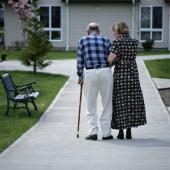- Skip Storing This Everyday Product in the Fridge Door
- Green Tea + B3 Pairing May Boost Brain Health
- Navigating Your Midlife Crisis: Embracing New Possibilities
- City Raccoons Showing Signs of Domestication
- Mapping the Exposome: Science Broadens Focus to Environmental Disease Triggers
- One Week Less on Social Media Linked to Better Mental Health
- Your Brain Changes in Stages as You Age, Study Finds
- Some Suicide Victims Show No Typical Warning Signs, Study Finds
- ByHeart Formula Faces Lawsuits After Babies Sickened With Botulism
- Switch to Vegan Diet Could Cut Your Greenhouse Gas Emissions in Half
40 Percent of Seniors Report Having a Disability


Nearly 40 percent of Americans over the age of 65 — about 16 million people — live with at least one disability, a new federal government report shows.
The findings are cause for concern because more than 13 percent of Americans (almost 41 million people) are older than 65, according to the National Institute on Aging report.
“With the first Baby Boomers having entered the 65-and-older ranks in 2011, the United States may experience a rapid expansion in the number of older people with a disability in the next two decades,” the report authors wrote.
“The future of disability among older Americans will be affected by how this country prepares for and manages a complex array of demographic, fiscal, medical, technological and other developments that will unfold in the next several decades,” they added.
The report, released Tuesday, analyzes U.S. Census data from 2008 to 2012. Researchers found the number of disabilities increased with age. In fact, people older than 85 accounted for more than 25 percent of all disabilities among seniors, although they represented only 14 percent of the overall senior population.
Seniors aged 65 to 74 accounted for 37 percent of seniors with disabilities, while those aged 75 to 84 accounted for 38 percent, the report showed.
Women accounted for almost two-thirds of the seniors with disabilities. However, older men were far more likely than older women to have serious hearing problems — 52 percent versus 32 percent.
Other seniors more likely to have a disability included those with less than a high school education, those who lived alone or lived in or near poverty, and those who were widowed, the report showed.
The report focused on six types of disability, including problems involving hearing, sight, thinking and memory, walking, self-care and independent living. The most common type of disability was difficulty walking or climbing stairs, which was reported by two-thirds of seniors with a disability.
Other common types of disability included problems with independent living (nearly 48 percent) and hearing problems (40 percent).
The good news was that about 61 percent of seniors didn’t have any of the six types of disability measured in the report.
While 16 percent of seniors had at least one disability, 8 percent had at least two and almost 15 percent had three or more disabilities, the report found.
Three or more types of disability were reported by 7 percent of those aged 65-74, 17 percent of those aged 75-84, and 42 percent of those older than 85.
Black and Hispanic seniors with a disability had higher rates of poverty, and blacks and whites with a disability had higher rates of living alone, the report noted.
About half of seniors with a disability lived in nine of the most populous states: California, Florida, Texas, New York, Pennsylvania, Ohio, Illinois, Michigan and North Carolina.
However, areas in the South, especially in central Appalachia and the Mississippi Delta, tended to have higher disability rates among seniors. The report found the highest rate (48 percent) was in Mississippi. The lowest rate (35 percent) was in Arizona.
“Disability can be reduced with improved medical treatment, positive behavioral changes, wider use of assistive technologies, rising education levels and improvements in socioeconomic status,” the report authors wrote.
More information
The U.S. Centers for Disease Control and Prevention offers tips for healthy aging.
Source: HealthDay
Copyright © 2025 HealthDay. All rights reserved.










